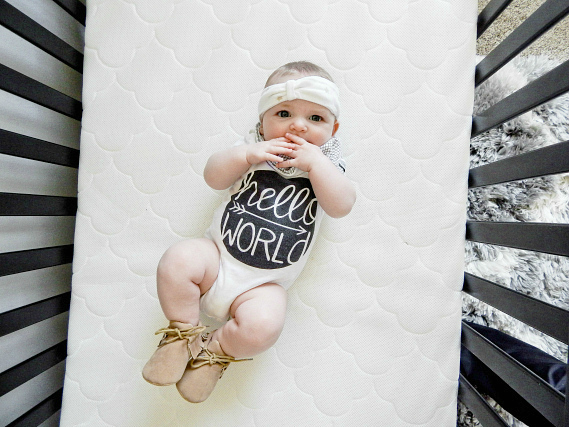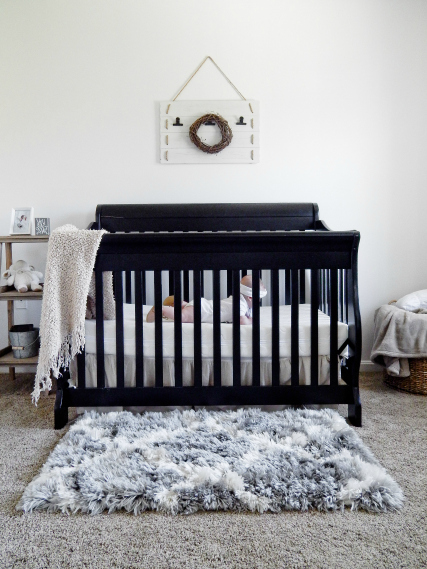Disclaimer: This post was sponsored by Newton. However, all thoughts and opinions are my own.
When we had our son, I was all about creating a strong bedtime routine. I heard from quite a few parents and sources that developing a bedtime routine would help him have good sleep habits for years to come. Obviously, when he was a newborn, he pretty much slept whenever he felt like sleeping. He would wake up every couple of hours in need of food throughout the night during the first few weeks but then those feedings started to spread out over time.
As a first-time parent, it was difficult transitioning our son into his crib. I loved having him sleep next to my bedside in his bassinet. Being able to peek on him throughout the night was one of my favorite things to do. Having him close by provided a sense of comfort and peace of mind. But, when the fourth month mark hit, I knew that it was time to make the transition.
We purchased a comfy mattress and sheet set and placed him in his crib. Before we knew it, he was sleeping through the night in his own bed … my baby boy was growing up. Since four month of age, our son has been sleeping through the night thanks to a bedtime routine we created for him when we made the big transition into his own room.
Know that the bedtime routine might adapt over time but you should try to stick to a similar routine every night. Children love and thrive on routine.
And then along came my daughter … she is opposite from her brother in almost every way possible except for her sleep pattern at night. A few days ago, my husband and I decided that at just a few days shy of four months, she was ready to make the transition into her crib since her bassinet was looking a bit too small for her and she was starting to show signs up falling asleep at around the same time every evening.
Just as we were talking about making the big transition for her, Newton reached out to me and offered to have us try out their Wovenaire® Crib Mattress. My son was a tummy sleeper and I had a feeling that my daughter was going to be a tummy sleeper too. My mother’s instinct was right.
Thankfully, every inch of the Wovenaire® Crib Mattress was designed with a baby’s health, safety, and comfort in mind. The innovative design allows air to flow freely for optimal breathability and temperature regulation. So, no matter how much she rolls around in her bed, I’m comforted by the fact that the mattress will allow her to breathe, even when sleeping on her tummy.
Wovenaire Crib Mattress’s perfect level of cushy firmness helps your baby stay asleep. Wovenaire Crib Mattress’s core is made of 90% free air – yes, air and 10% food-grade polymer. It’s all wrapped up in a breathable, three-dimensional fabric that provides comfort and unzips for easy washing. Wovenaire Crib Mattress contains no foam, latex, springs, glue, or allergens and is 100% recyclable. Plus, the washable material prevents bacteria growth – and allows you to rinse off any less-than-adorable moments. What’s not to love?
Do you want to try out the Wovenaire Crib Mattress? Be sure to visit this site and use the code below.
5 Tips on Developing a Bedtime Routine
So, now that we have a mattress we love, it’s time for us to focus on creating a bedtime routine for our daughter. My son has always been an incredible sleeper at night starting at just four months of age. Here are some tricks I learned the first go around with our son that I plan on using for our daughter.
1.) Set a Bedtime
When my son started sleeping in his own room, his bedtime was a strict 7:00 p.m. and it stayed that way until he was two. Having a set bedtime allowed his internal clock to adjust and know that when it hit 7:00 p.m. he was ready for bed. The bedtime followed a natural and consistent pattern. Yes, there were times that he went to bed a little after 7:00 p.m. but we really tried to keep it as close to 7:00 p.m. as possible. Now that he’s three, we’ve pushed his bedtime to 7:30/8:00 p.m. (and sometimes later if we are doing something that keeps him up (but never later than 8:30 p.m.). But, thanks to the routine (see #5), he knows that after the routine, it’s time to fall asleep through the night.
2.) Eat Food Right Before Bed
For our son, we eat dinner, he washes his hands and face, and then he knows that it’s time to go upstairs and go to bed. We’ve always been late dinner eaters (habits we developed before having kids) but it helps him to know once dinner is done it’s bedtime.
If you eat dinner earlier in the evening, then offer your child a light snack before bedtime. A food that is carbohydrate and protein heavy will make your child sleepy.
If you have a baby, give your baby one last feeding in his/her room right before placing him/her in the crib. I would even read our baby a story and then give the bottle before placing him in the crib. That way, he started to learn that after he was changed into his pajamas, he was going to be read a book, given a bottle, and then placed in bed to go to sleep.
3.) Take a Bath
Our kids are morning bathers but I know (from friends) that a bath before bedtime helped calm the child (especially if the bath time suds are infused with lavender). When our son was a baby, we gave him a bath before bedtime to help calm him. But, because we are all morning bathers in our family, we did away with this routine for him since I didn’t want to give him two baths a day in fear of drying out his skin. I do know that the bath did help to calm him down. And, I know that friends love the nighttime bath time routine with their kids.
4.) Keep “Goodnights” Brief
When it comes to my son’s bedtime routine, we’ve always read him a book before bed. After we read him one book, he goes straight into bed. We tuck him in once (even though he keeps asking for more “tucks”), say “goodnight,” tell him we love him, and then close the door. Kids are smart. So, even if he keeps asking us to go back into his room, we don’t. I know it might sound harsh. But, if you keep going back into the room, then the child will quickly learn that they can condition you to go back into the room easily by just calling for you.
5.) Practice Repetition
Repetition is key when it comes to a bedtime ritual. Every night, be sure to try and do the same routine in order to show your child that this routine will lead to bedtime.
For instance, with our son, we have him say “goodnight” to the parent who is not doing the bedtime routine. Then, he walks upstairs and into his room. From there, we change his diaper and put him in pajamas. Then it’s into the bathroom so that he can brush his teeth. We close the curtains, turn on the sound machine, and sit down on the couch in his room to read one book. He puts the book away and then gives the parent a hug and kiss before going into bed. We tell him goodnight and that we love him and then it’s lights out. We shut the door and walk downstairs. He might not be asleep by the time we leave his room but we keep an eye on him on the monitor to make sure he stays in bed. It might take him a while to actually fall asleep but he eventually falls asleep and stays in bed.
What are your favorite tips for developing a bedtime routine?
Disclaimer: This post was sponsored by Newton. However, all thoughts and opinions are my own.











Leave a Reply